GET THE DEALS
If you’re looking in the Breville Barista Touch Impress and surprise if it’s price the depositing, you’re in the right way place.
I run the Coffee Kev, where I review coffee machines with no sponsors,no freebies, andwhole-hearted. I buy every machine with my own money so I can give you an honest, real-world opinion, not marketing embrangle
Breville is a seriously intelligent brand. They’ve built a reputation for making some of the smartest and most user-friendly espresso machines on the market, and this latest release takes things to another level. I went into this review expecting precision and polish. What I didn’t expect was to walk away thinking:
“This might actually be one of the best home espresso machines ever made… for most people.”
But the real question is: Is it the right machine for you?
Since this article is quite in-depth, I’ve broken it down into four main sections. Feel free to jump straight to the part that interests you most:
Backstory on the Breville Barista Touch Impress
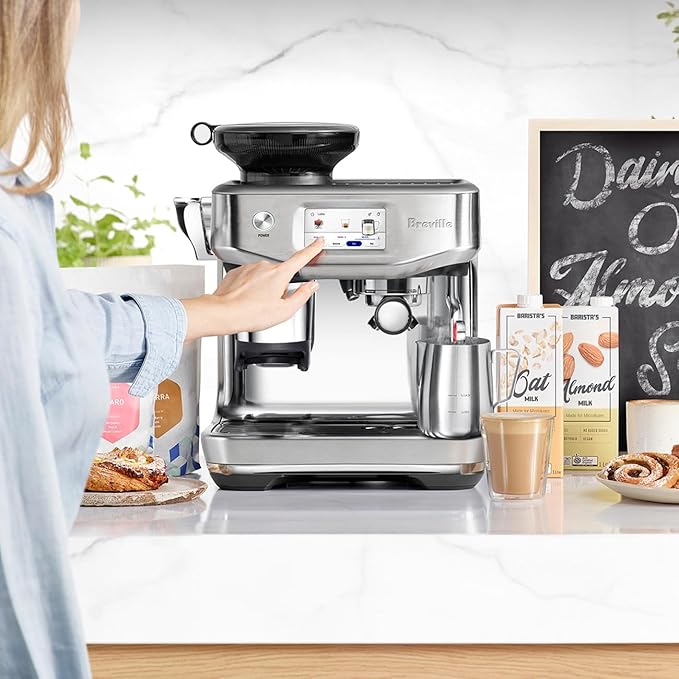
Breville isn’t your average coffee machine brand, far from it. This is a company with specialty coffee at its core, even if that’s not how everyone sees it at first glance.
Table of Contents
From Radios to Ristrettos
Breville started way back in the early 1930s in Sydney, Australia. It was founded by:
- Bill O’Brien
- Harry Norville
(Yes, that’s where the name “Breville” comes from, Br from O’Brien and –ville from Norville.)
Their first product? A radio.
Fast-forward to today, and Breville has grown into a global kitchen appliance brand, but make no mistake:
Coffee is where their heart is.
“Not a Specialty Brand”? Think Again
Some home baristas still snub Breville as a “standard domestic brand.” Why?
- Their machines are sleek, kitchen-counter friendly.
- They manufacture in China, which unfairly lumps them into the “budget” category by people who judge by looks or origin.
But here’s the thing:
- Breville was focusing on specialty coffee features long before it was trendy.
- Even in the early 2000s, their machines were shipping with:
- A 9-bar OPV (Over Pressure Valve)
- Brew temperatures hitting the ideal 200°F
- Low-pressure pre-infusion to avoid channeling
These aren’t just marketing checkboxes. These are features aimed squarely at people who actually care about espresso.
The Blessing and Curse of the Barista Express
Breville’s big breakout came with the Barista Express, a machine that looked like a best-of-both-worlds setup:
- The ease and convenience of a super automatic
- The quality and flexibility of a home barista setup
At least, that’s how many retailers marketed it.
But let’s clear this up:
- The Barista Express is not an automatic machine.
- It’s a semi-automatic espresso machine with a built-in grinder.
Retailers kept listing it under automatic machines because it sold like hotcakes. And who can blame them? It still does. But…
That misclassification has probably caused Breville a lot of customer support headaches.
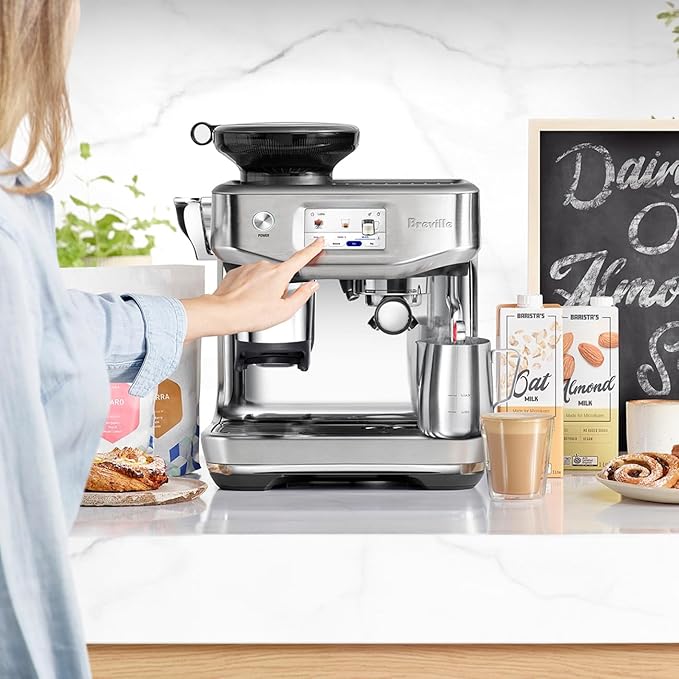
A Quick Geeky Note on Pressure
Now, for anyone into the more technical side of things:
You may have noticed that the Barista Express is the odd one out when it comes to pump pressure. Unlike Breville’s other machines that use a 9-bar setting, the Express runs at something like 13–14 bars.
Why?
I don’t know for certain, but I suspect it’s a workaround for its misplacement in the market. If people are using it like a fully automatic machine, maybe the higher pressure was meant to better handle inconsistent tamping or grind sizes.
Either way, the Express wasn’t meant to be hands-off. It’s a manual machine at heart, and the Touch Impress builds on that legacy in some very clever ways.
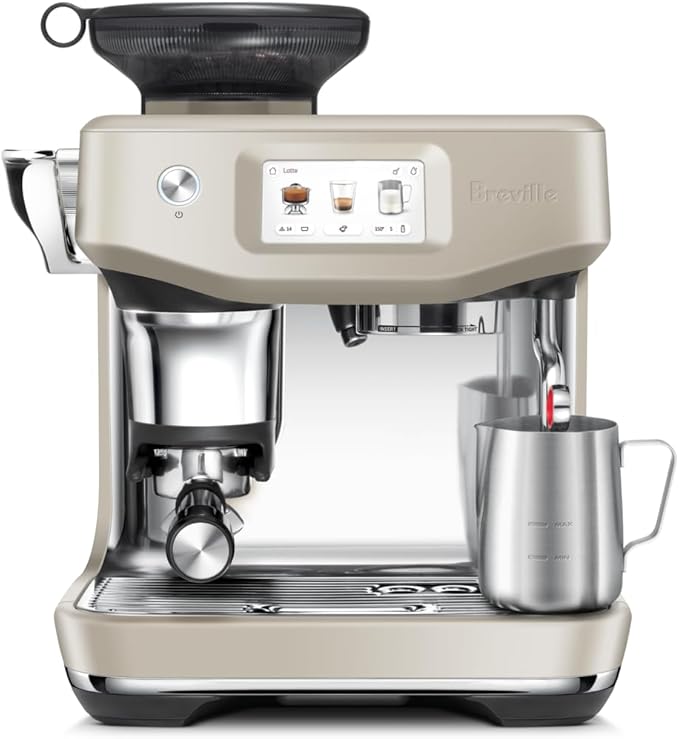
Why the Pressurized Baskets?
Another little curveball with the Barista Express, and possibly another clue that Breville knew how their machine was being used, was their decision to ship it with:
- Pressurized (dual-walled) baskets, instead of standard single-walled baskets.
These days, you’ll usually get both types in the box, but initially, I think Breville leaned toward the pressurized ones to:
- Make the machine easier for beginners
- Improve shot consistency for people using pre-ground or supermarket beans
- Work better with that higher pump pressure I mentioned earlier
And yes, that kind of pressure management actually works better with pressurized baskets.
Apologies if your eyes have just glazed over, don’t worry, I’ll try to keep the rest of this post as non-geeky as I can 🙂
Wait, Is the Touch Impress an Espresso Machine?
Just to clear the air for anyone new to this, yes, this is an espresso machine. And if you’re not super deep into coffee geekery (yet!), let me explain why that matters.
I’m writing this for everyone, from casual coffee drinkers to full-on specialty coffee lovers, so let’s start with a simple but essential point:
All your coffee shop favorites, Cappuccino, Latte, Flat White, Americano are built on one foundation: espresso.
So, if you want to make these kinds of drinks at home, you really need an espresso machine, not just a “coffee machine.”
What’s the Deal with Super-Automatics?
Not all espresso machines are the same. Here’s where super-automatic coffee machines come into play:
- They’re called “super-automatic” because they do everything for you.
- They grind the coffee, dose it, tamp it, and brew your espresso with zero fuss.
- They use an internal brewing unit rather than a traditional portafilter.
And yes, they do make espresso, just not in the same way a traditional machine does.
Super-automatics are perfect for convenience seekers. They crank out café-style drinks quickly and easily, and the cup quality is more than good enough for most people.
Here’s the rub:
If you’ve got a well-trained palate or you’re used to third-wave coffee quality, then you might find the espresso from most super-automatics a little… underwhelming:
- Less intensity
- Lighter body
- Less nuanced flavor
That’s because super-automatics tend to sacrifice a bit of control and quality for convenience.
But what if you want the best of both worlds?
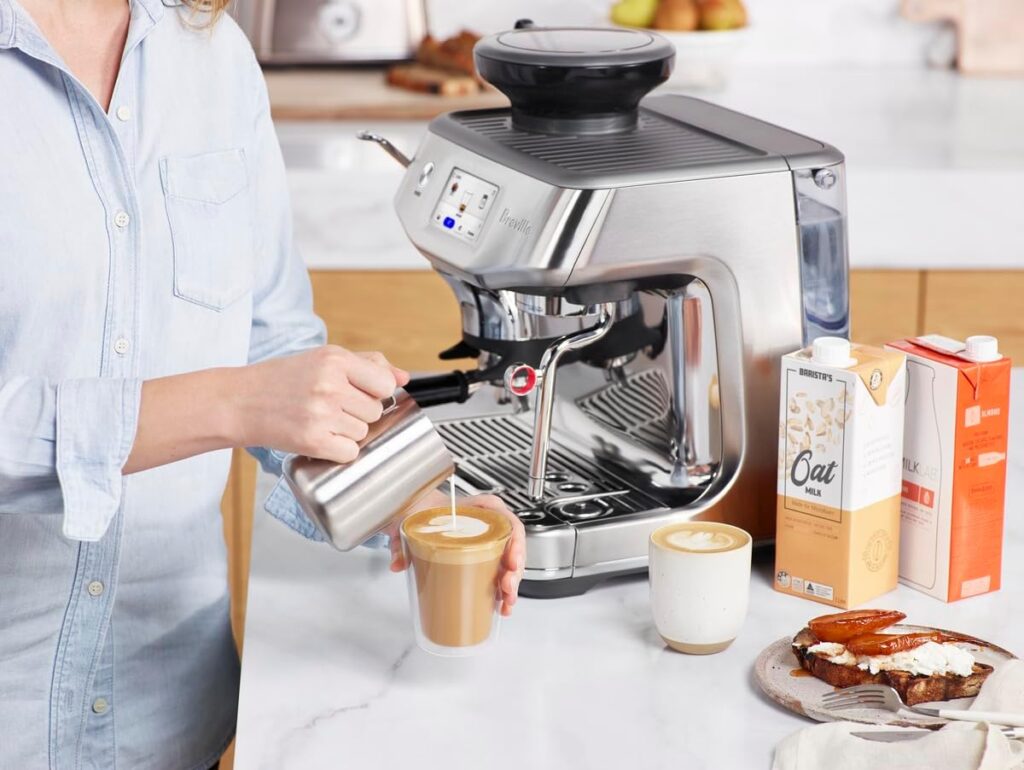
Breville’s Breakthrough: Automating Specialty Espresso
They figured out a way to bring specialty-level espresso into the world of automation, starting with their Oracle and Oracle Touch machines.
Instead of going the typical super-auto route, Breville focused on automating the right things:
- High-quality grinders
- Precise dose control
- Automatic tamping
- Low-pressure pre-infusion
- 9 bar brew pressure
- Stable brew temperatures
The result? Machines that still use portafilters deliver real espresso quality but with way less manual effort.
The only issue?
They’re brilliant, but not cheap.
Don’t worry, though. The Barista Touch Impress brings much of that magic to a much more approachable price point… and that’s exactly what we’ll dig into next.
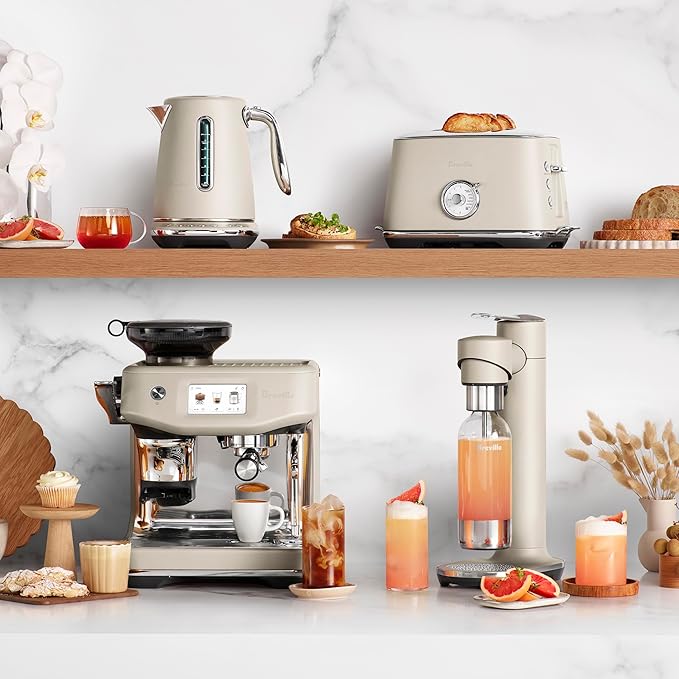
The Barista Express Impress: What Everyone Expected From the Start?
The Barista Express Impress was introduced about a year ago (at the time of this writing) and almost instantly became one of the best-selling coffee machines on the market.
Why? Simple: It finally delivered the kind of experience many users thought they were getting with the original Barista Express.
Barista Express Impress
The Confusion Around the Original Barista Express
Let’s rewind a bit.
- For years, many retailers have marketed the Barista Express as an automatic machine that offers cup quality at home-barista level.
- That wasn’t exactly true. The original Express is a semi-automatic machine with a built-in grinder, but not an automatic machine by any stretch.
The Barista Express Impress, though?
Now we’re talking.
Breville’s Smart Move: Assistance, Not Automation
This machine is a real breakthrough. Why?
Because Breville focused on assistance instead of full-blown automation in two key areas:
- Dosing
- Tamping
This made a huge difference, because:
- It kept costs down (less need for complex electronics).
- It kept the machine flexible and user-friendly.
- It made home-barista-style espresso way more accessible.
And crucially, they did it using the Barista Express platform instead of the much pricier Dual Boiler platform (which powers the Oracle line).
Flexibility for the Whole Household
One of the most underrated wins with the Barista Express Impress is its flexibility.
You can use it in three modes:
- Fully Manual (“Geek Mode”) – Total control, perfect for the espresso nerd in the house.
- Fully Assisted – Let the machine help you with dose and tamp, great for everyday ease.
- Semi-Auto (The Sweet Spot) – My personal favorite. You get precision and ease, without losing the fun of brewing.
This hybrid approach makes it ideal for shared households where:
- One person wants to dial in the grind and perfect their puck.
- Everyone else just wants a coffee that tastes great with minimal faff.
The One Missing Piece…
I’ve used the Barista Express Impress a lot, I’ve even made about a dozen YouTube videos on it so far.
I think it’s an incredible machine for what it is.
But…
It still doesn’t quite compete with true one-touch super automatics, mainly because:
- The interface isn’t as intuitive or visual.
- There’s no automatic milk frothing (a big one for those who love lattes and cappuccinos without the steam wand learning curve).
This brings us nicely to:
The Barista Touch Impress In-depth Review
When I first started putting out videos on the Barista Express Impress, a theme quickly emerged in my comments and inbox:
“Kev, I love this machine, but will there be a version with auto milk frothing and more super-auto features?”
I figured Breville must already be working on it. It just made sense. But when I finally got my hands on the Barista Touch Impress…
I wasn’t just impressed, I was floored. They should’ve called it the Breville Miracle!
Feature Highlights: What Makes The Touch Impress a Miracle?
Let’s take a look at why the Barista Touch Impress is such a big deal. Here’s what it brings to the table:
Familiar with the Barista Express Impress
- Tap “Milk” on the screen
- Tap “Espresso” after that
- Go find your keys, phone, socks (or all three)
- When you come back, everything is done
For an Americano, you don’t even have to pour anything. Just tamp, move the portafilter into the group head, and the machine takes care of the rest.
3. Auto MilQ™ – Dairy-Free Drinkers Rejoice
This might be the first machine I’ve tested that gives real attention to alternative milk:
- Just tap the type: Dairy, Soy, Oat, or Almond
- The software adjusts temp and texture accordingly
- You can tweak these to your liking and save them
As someone who now uses Oat milk due to dairy intolerance, I was honestly touched by this level of thoughtfulness.
Who Is The Breville Touch Impress For?
Most people don’t want to faff with espresso technique; they want results. High-quality drinks with low hassle.
- People who want café-quality drinks at home
- People who value convenience over geekery
- Families or households with mixed skill levels
- Dairy-free drinkers who’ve been overlooked until now
Can It Brew & Steam at the Same Time?
Nope, the Barista Touch Impress isn’t a dual-boiler machine, so technically it can’t brew espresso and steam milk simultaneously. But here’s the clever workaround:
Espresso & Milk, Queued for Convenience
Breville’s thought of everything:
- Place your milk jug under the steam wand.
- Tap the milk icon on the screen.
- Then tap the espresso icon.
Now? Go about your morning chaos, whether that’s hunting for your keys, your phone, or (if you’re like me) realizing you’re not actually wearing pants yet.
By the time you’re back:
- The machine has steamed your milk to your preset temperature and texture.
- Then it automatically pulls your espresso shot once the milk is done.
All that’s left for you to do? Pour the milk into your cup. Done. Café-style drink, minimal faff.
Americano? Even Easier.
If you’re an Americano drinker, it’s even more streamlined:
- Tamp.
- Move the portafilter into the group head.
- Tap the button, and it does the entire job, including dispensing hot water.
There is no waiting, no multi-step manual effort. This is almost like having a barista hiding in your kitchen.
Auto MilQ™ Technology: A Game-Changer for Non-Dairy Drinkers
Let’s talk milk, because this is where the Touch Impress really flexes its intelligence.
I’ve had to make the switch to Oat milk due to developing a dairy intolerance (and if you’re in the same boat, you’ll know the struggle of getting alt-milk just right).
Breville gets it, and they’ve baked it into the firmware:
Milk Preset Options (Just Tap the Screen):
- Dairy
- Soy
- Oat
- Almond
Each preset has its own steam temperature and froth profile, tailored to that milk’s texture and behavior when steamed.
But it doesn’t stop there:
- You can adjust both the froth level (stretching) and temperature to your preference.
- Save your custom recipes under personalized drink profiles.
In other words, whether you want extra microfoam in your oat flat white or cooler almond milk for an iced drink, it’s got you covered.
What Does All This Actually Mean?
✅ Super-Auto Experience, Home-Barista Cup Quality
This is the dream for most people.
Let’s be honest, folks like me, the ones who enjoy spending 45 minutes perfecting a shot of espresso, are the exception.
Most people:
- Don’t want to become a barista, they just want barista-quality drinks.
- Don’t want to mess about with steam wands, they want silky milk now.
- Want their morning coffee without also needing a second coffee to recover from making it.
In the past, the only way to get home-barista-level drinks was to:
- Learn a bunch of techniques.
- Get the gear.
- Fail a lot until you got good at it.
But now?
You just need the Barista Touch Impress.
It gives you:
- The quality of a skilled barista setup,
- With the convenience of a super-automatic.
That, for me, is the real magic of this machine.
Does the Barista Touch Impress Beat Super-Automatics on Cup Quality?
Let’s tackle the big question that many people have, especially if you’re weighing this up against a super-automatic machine:
Is the Espresso Actually Better?
Yes, but it depends what you’re drinking.
If you’re a fan of neat espresso or Americano, you’ll likely notice a big difference between what a traditional espresso machine like the Barista Touch Impress can produce versus a fully automatic machine.
Why?
- Super-automatics tend to deliver less intense, thinner-bodied espresso.
- Traditional portafilter-based machines (like this one) allow better extraction control, resulting in a richer, more nuanced shot.
But here’s the thing…
Milk-Based Drinks? The Difference Shrinks
When it comes to cappuccinos, lattes, or flat whites, the milk tends to mask small differences in espresso flavor. So for many people, a decent super-auto is “good enough” for milkies.
Still, the real game-changer, and the thing most super-autos get wrong, is…
Milk Frothing: The Super-Auto Achilles’ Heel
Here’s the issue with most one-touch machines:
- Foam quality is often poor, bubbly, inconsistent, or overly thick.
- Temperature control is limited or nonexistent, which is why a lot of folks microwave their coffee after making it!
Yes, really. I’ve lost count of how many people have told me they nuke their latte just to warm it up properly.
Enter: Barista Touch Impress Milk Frothing
The milk froth produced by this machine is, frankly, barista-level.
- Silky smooth microfoam, the kind you can pour latte art with.
- Perfect temperature every time, no guesswork.
- Consistency across pitchers, and that is huge.
Let me just say: I spent years learning to properly texture milk. It’s not as easy as baristas make it look, especially when you’re trying to get consistent texture from one jug to the next.
This machine? It does it every time. And it lets you:
- Adjust the temperature (up to 167°F / 75°C).
- Control the texture (froth level).
- Save your preferences per drink.
- Create custom versions, like a “hotter latte for Kev” or a cooler one for your partner.
Personally, I go for 140–150°F. Anything hotter and you start heading into crappuccino territory (yes, that’s my term for over-frothed, burnt milk cappuccinos).
Oh, and remember the espresso queuing feature? That helps too. Milk holds its heat better than espresso, so if the shot comes right after the milk finishes, it all stays warmer and better balanced.
Microfoam That Actually Deserves the Name
Most super-automatics that claim to make “flat whites”… don’t.
Instead, you press the “Flat White” button all excited, only to get:
- A slightly smaller latte…
- With foam that’s too thick or bubbly…
- And definitely not what your local specialty coffee shop would call a flat white.
What Makes the Barista Touch Impress Different?
- Real microfoam, smooth, fine-bubbled milk that blends seamlessly with espresso.
- Flat white texture, yes, proper flat white texture at the touch of a button.
- Superior frothing for both dairy and alternative milks.
Whether you’re drinking oat, almond, soy, or regular dairy, the Barista Touch Impress is miles ahead of anything I’ve tested from super-automatics when it comes to milk texture.
Is the Barista Touch Impress More Convenient Than Super-Automatics?
OK, I know, this is going to ruffle some feathers.
Some espresso purists might be peering down their noses at this claim, but hey, peer all you like. In my honest opinion, the Breville Barista Touch Impress isn’t just equal in convenience to super-automatic machines; in some ways, it’s even more convenient.
Lightning-Fast Heat-Up
Thanks to Breville’s ThermoJet heating system, this machine heats up in just 3 seconds.
- Compare that to most one-touch machines, which usually take 30–60 seconds.
- The faster heating and cooling also mean quicker milk steaming and a faster return to espresso temperature.
So, from power on to drink in hand, it might actually beat many super-automatics in overall speed.
But Isn’t a Super-Automatic More “Hands-Free”?
Not as much as you might think.
Let’s be real here, even with the fanciest, most advanced one-touch machines, you still need to:
- Get your cup from the cupboard.
- Get milk out of the fridge and pour it into the carafe.
- Attach the carafe to the machine.
Unless your machine has arms, knows where you keep your mugs, and can open your fridge, you’re still involved.
Now let’s talk about what you actually have to do with the Barista Touch Impress:
- Pop the portafilter into the grinds cradle.
- Pull the tamp lever.
- Tap the touchscreen to queue up your espresso and milk.
That’s it. While the machine steams your milk and then pulls your shot, you can be off finding your phone, your keys, maybe even your pants.
A Word About Cleaning
Here’s a big win for the Barista Touch Impress, milk cleanup is easier than with most super-automatics.
With a typical super-auto:
- You’ve got a milk carafe or tubing system.
- You need to wash it thoroughly every day.
- Swapping between milk types (e.g., dairy to oat) can be a pain.
With the Barista Touch Impress:
- Just wipe the steam wand and rinse the pitcher.
- Want to switch from dairy to oat milk? Rinse, wipe, go.
No disassembly, no soaking, no fiddling with tubes or containers.
Multiple Milks? No Problem.
Another scenario where this machine shines:
Let’s say one person in your household uses dairy milk, and another uses oat or almond milk.
With a super-auto:
- You’d need to empty and clean the milk system, then refill it with the other milk.
- That’s a chore, every time.
With the Touch Impress:
- Rinse the jug.
- Wipe the wand.
- Select your milk type on the screen (Dairy, Oat, Almond, or Soy).
- Done.
In Summary: Touch Impress Convenience Wins
What makes it more convenient?
- Faster heat-up & steaming.
- No milk carafe hassles.
- Simpler cleanup.
- Easier milk switching.
- You don’t need to stand there while it makes your drink.
This might not be exactly one-touch, but it’s as close as it gets, without sacrificing cup quality, and in fact, while improving it.
Do You Really Have to Knock Out the Portafilter Every Time?
Yes, you do, but let’s not overdramatize. It’s a quick knock on the knock box and a quick wipe with a cloth. That’s it.
Now, before anyone starts touting the “set-it-and-forget-it” convenience of super-automatics, let’s have a closer look at what they require:
What About Super-Auto Cleanup?
Super-automatic machines also need regular attention when it comes to spent coffee grounds:
- Most have an internal dreg drawer that holds 5–12 used pucks.
- Once full, you have to:
- Open the front door of the machine.
- Remove the drip tray.
- Remove the dreg drawer.
- Often, empty both at the same time (since they’re usually stacked together).
Compare that to the Barista Touch Impress:
- Knock puck into a knock box (takes 2 seconds).
- Wipe portafilter (another 2 seconds).
- Done.
And the Drip Tray?
Let’s not forget another small but handy point:
- With the Barista Touch Impress, the drip tray simply slides out for emptying.
- With most super-automatics, again, open the door, remove internal tray, balance it over the sink, etc.
So Which Is More Convenient?
Honestly? It’s a draw, or maybe even a win for the Touch Impress.
Yes, you knock out a puck. But you skip the awkward disassembly, less cleaning of internal compartments, and no dealing with milk carafes or tubing.
Like I said earlier, I’d be willing to trade a bit of convenience for this level of cup quality, but with this machine, you really don’t have to.
When you look at everything, usability, setup, cleanup, speed, flexibility, the Barista Touch Impress is at least as convenient as a super-auto. Maybe more.
Is the Breville Barista Touch Impress Worth the Cost?
This is the big one, and it’s a fair question.
“Is it worth it?” comes up a lot with high-end machines, and honestly, the answer isn’t always yes. But in this case?
✅ It’s a Big YES – Here’s Why:
When I first heard about the Barista Touch Impress, I feared it would be priced higher than the Oracle Touch, maybe creeping toward the $3,000 mark.
But nope, Breville surprised me!
The Barista Touch Impress retails around $1,500, and here’s why that’s impressive:
- That’s WAY less than many DeLonghi super-automatic machines.
- And yet, it delivers:
- Better milk texture
- Better espresso
- More control
- A fully guided user experience
- Not to mention a cleaner, simpler milk system with personalized settings and alt-milk optimization.
So, while “worth it” is always relative to your needs and budget, if you’re looking at machines in this price range or higher, this is one of the best value machines out there, in my opinion.
Is the Breville Barista Touch Impress the Right Espresso Machine for You?
Let’s be honest, there’s no one-size-fits-all when it comes to home espresso.
But if there were something close to a “one-size-fits-most,” it would probably be your typical super-automatic coffee machine. And that’s exactly the territory the Barista Touch Impress dares to improve upon.
Is This Machine for You?
Let’s break it down:
✅ The Barista Touch Impress is probably for you if:
- You’ve owned automatic machines before and were mostly happy with them.
- You wish your milk drinks were hotter or the texture were more consistent.
- You’d love to create coffee shop-quality cappuccinos or lattes at home, without needing a barista course.
- You want something simple for everyone in the household to use.
- You’re not looking to geek out on espresso technique but want excellent results at the touch of a button.
❌ It’s probably not for you if:
- You’re already eyeing machines like the Gaggia Classic, Rancilio Silvia, Lelit Mara X, or Rocket Appartamento.
- You’re getting serious about the home barista lifestyle and want to control every variable manually.
- If you’re looking for manual override flexibility for complete experimental freedom, the Barista Express Impress might be more your style.
One Machine to Please Them All?
If you’re thinking:
“I want the barista experience, but the rest of the household just wants something easy.”
This could still be a great middle ground, with a caveat.
- The Barista Touch Impress offers incredible simplicity and fantastic results.
Bottom of Form


